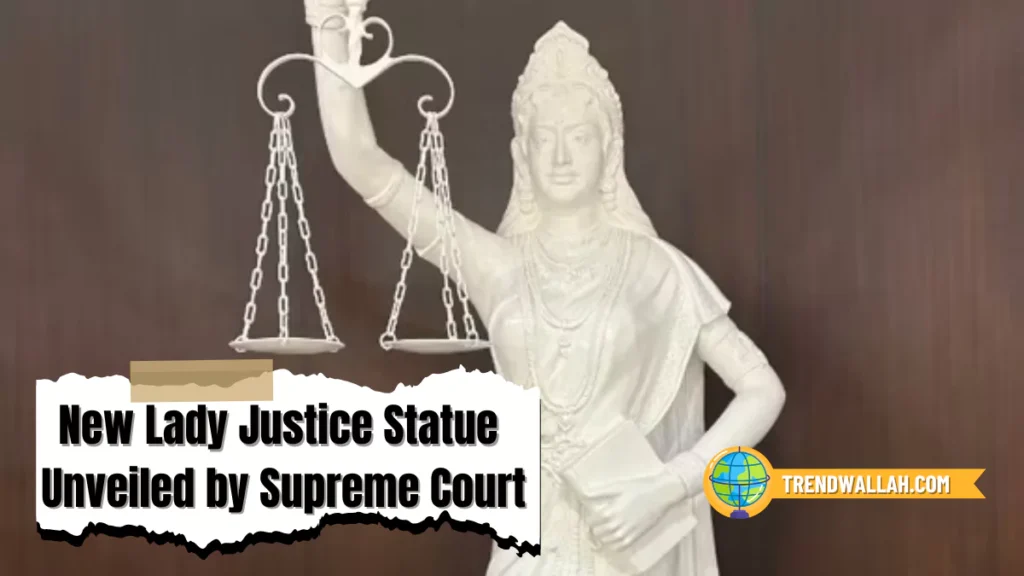
The Supreme Court of India has introduced a redesigned version of the iconic ‘Lady Justice’ statue, symbolizing a significant shift from traditional colonial imagery. The statue, traditionally depicted with a blindfold and a sword, now features open eyes and holds the Constitution of India, reflecting a modern, inclusive interpretation of justice under the leadership of Chief Justice D Y Chandrachud.
Key Features of the Redesigned Statue
- Open Eyes: The statue’s open eyes represent awareness and a shift from the traditional concept of ‘blind justice.’ This signifies that the judiciary sees and understands the complexities of society, ensuring fairness and inclusivity.
- Constitution Instead of Sword: The statue now holds the Constitution of India, replacing the sword. This change emphasizes justice rooted in constitutional values rather than punishment.
- Cultural Attire: Unlike the previous Western-style robe, the statue is dressed in an Indian saree, reflecting cultural identity and the transition to a modern Indian judicial system.
Significance of the Changes in Lady Statue
These updates symbolize the judiciary’s commitment to move away from colonial-era symbols. Chief Justice Chandrachud has emphasized that “the law is not blind; it sees everyone equally,” reinforcing that the judicial system should be protective of constitutional rights rather than punitive. The redesigned statue embodies this philosophy.
Chief Justice of India DY Chandrachud has unveiled a new statue of Lady Justice, removing her blindfold and replacing the sword with the Constitution. This transformative symbol reflects a commitment to constitutional values and equality before the law. #Justice #CJIChandrachud pic.twitter.com/3orY71U2cy
— DD News (@DDNewslive) October 17, 2024
Retaining the Scales of Justice
Despite these changes, one feature remains unchanged — the scales of justice. They continue to represent balance and impartiality, ensuring that all parties are treated equally before the law.
Key Differences Between Old and New Lady Justice Statues
| Feature | Old Statue | New Statue |
| Blindfold | Present, symbolizing impartiality | Removed, representing awareness |
| Eyes | Closed, reinforcing the blindfold’s meaning | Open, showing vigilance and understanding |
| Item Held in Left Hand | Sword, symbolizing authority and punishment | Constitution, representing justice values |
| Attire | Western robe | Indian saree, reflecting cultural shift |
| Symbolism of Scales | Represented balance and fairness | Unchanged, still symbolizing impartiality |
New Lady Justice Statue- News Summary:
- Supreme Court of India unveils redesigned Lady Justice statue.
- Changes led by Chief Justice D Y Chandrachud, symbolizing modern judicial values.
- New features include open eyes and Constitution, replacing traditional blindfold and sword.
- Attire changed from Western robe to Indian saree, reflecting cultural identity.
- Symbolizes a shift away from colonial legacy towards constitutional fairness and inclusivity.
Also Read Latest Current Affairs 2024
The redesign represents a shift away from colonial symbols, emphasizing constitutional values and inclusivity.
The new statue holds the Constitution of India, replacing the sword, symbolizing justice based on constitutional principles.
The open eyes symbolize awareness and understanding, moving away from the traditional notion of ‘blind justice.’
The blindfold was removed to indicate that justice is not blind; it sees and understands the complexities of society.
No, the scales still represent balance and impartiality, ensuring fair judgment.
The Indian saree signifies a shift towards an Indian identity, moving away from colonial influences.
It conveys a modern, inclusive approach to justice, rooted in constitutional values and fairness for all.
